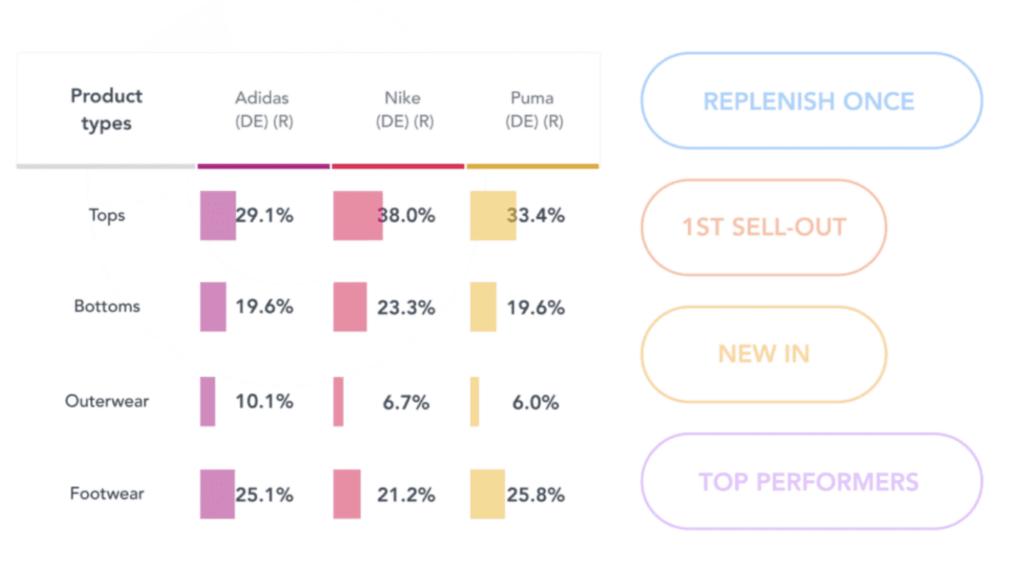Apparel, Footwear & Accessories, Trend Identification
Menswear Fall 2023 Buyers’ Guide
The most commercial trend highlights to back from the Fall 2023 runways, paired with data insights.
Let’s begin by exploring the definition of competitive shopping. Retail comp shopping, or seasonal competitive shopping, entails comparing prices and products from different competitor brands and retailers. Comp shopping is an invaluable tool for visual merchandising and brand and retail businesses to stay relevant and competitive. They do this by offering the best assortments and prices ausing their knowledge of the retail industry and in-season consumer shopping trends in 2023 and beyond.
Competitive shopping helps improve your knowledge of localized product trends and provides feedback that supports your product development process. Nostalgic perks for the merchandiser previously included travel to fashion capitals to explore competitors and the market in person. However, increased saturation, globalization and proliferation of online channels and needs for operational efficiency have seen travel often replaced with volumes of manual data analysis and increasingly limited travel.
How many of these situations sound familiar to you? Are you manually surfing the web on competitive sites and visiting local stores to find out what is selling when everything is trending? How many hours do you spend searching trends, assortments and prices for in-season trading and longer term planning? Even more importantly, how can you stay competitively priced against key players in your market to ensure you remain relevant? You manage multiple data sources. Trying to export all data to Excel is highly manual.
With retailers amplifying the number of products on their comms sites (a 29% increase for Q3 2022 vs. Q2 2022 in the US alone), analyzing the data from the items you care about within the billions of SKUs can be a time-consuming and costly exercise.
Having a 360-degree view of both your competitive marketplace and your business means no more blind spots or guesswork. Traditional web surfing and store comp shopping do not provide merchandisers with the customer data they need. Discover why you need a 360-customer view of merchandising here.
There are several ways to automate retail ‘comp’ shopping. One way is to use a software program that automatically collects competitive price, category and assortment data from competitors. Another way is to use a website to aggregate these data points from different retailers. In a recent article, McKinsey & Co. estimated that applying integrated digital solutions to merchandising could lead to up to a 50% faster time to market, an 8% rise in full-price sell-through and a 20% decline in manufacturing costs.
Once you have collected price data, compare prices from different retailers. You can also use it to track price changes over time to make informed assortment and pricing decisions.
Leading global retailer Mango is established in over 50 countries worldwide and uses comp shopping to deliver customer centricity. “MANGO must have a global and local vision of the company’s positioning in each market to execute our strategy. We have different competitors around the globe. MANGO must adapt products and prices to the customer needs in each country,” said Marta Setien, Director of Pricing at MANGO.
Automating retail comp shopping can save businesses time and money. It can also help businesses to stay competitive and offer the best prices to their customers. In a modern world, where more products are being added to assortments that rely on timeliness, speed to trends and more data-backed decisions when it comes to in-season trading and adding additional seasonal styles for best-performing categories, it’s only natural that brands and retailers are looking for automated solutions to take the guesswork out of comp shopping.
Stay relevant and remove manual comp shopping processes through automation. Benchmark your assortment locally or globally, aligned to your company objectives. You can drive revenue and increase market share by unlocking real-time and historical views of your market and customers through investment in retail analytics software.
EDITED understands that competitive shopping is a headache. We exist to empower people like you to put data behind your decisions and focus on customer centric merchandising. We marry a competitive perspective of customer preferences with a business view into product preferences, marketing touchpoints, location preferences, costs, returns, reviews, shopping behavior, loyalty, profitability and more. We bring you closer to your customers so you can drive personalization and brand loyalty. We help clients change the narrative from what is selling to why it is profitable, which customers are optimal, how to make more profit and what the action trade-offs look like. In addition, we can surface opportunities around new markets, new lines and new channels. These insights will influence both driving revenue and controlling costs.

